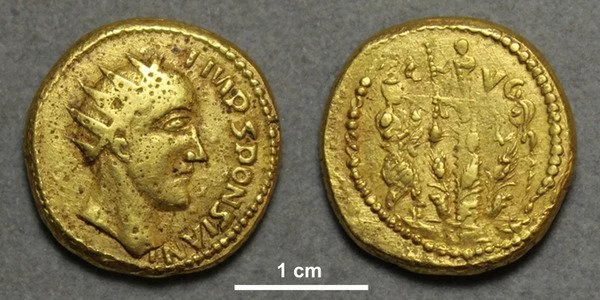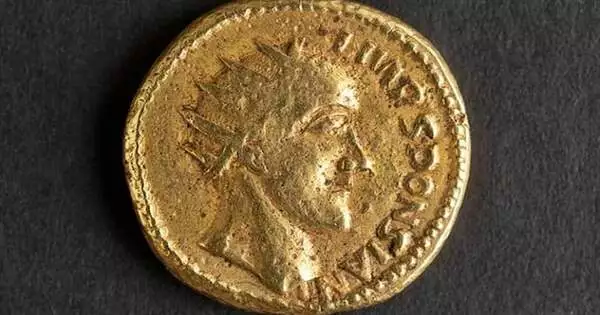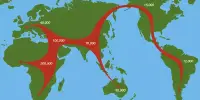It is possible that a discovery of ancient Roman coins could reveal a previously unknown or long-lost emperor. Coins were an important means of disseminating propaganda and political messages during the Roman Empire, and they often featured the image of the reigning emperor. So, if a set of coins were discovered featuring the image of an emperor who is not recorded in history, it could indicate the existence of a previously unknown ruler. However, it would require further research and historical investigation to confirm this.
According to a new UCL-led study, a gold coin long dismissed as a forgery appears to be authentic and depicts a long-lost Roman emperor named Sponsian. The coin, which is housed in The Hunterian collection at the University of Glasgow, was discovered in 1713 in Transylvania, which is now part of Romania. Because of their crude, strange design features and jumbled inscriptions, they have been regarded as forgeries since the mid-nineteenth century.
In the new study, published in PLOS ONE, researchers compared the Sponsion coin with other Roman coins kept at The Hunterian, including two that are known to be genuine. They found minerals on the coin’s surface that were consistent with it being buried in soil over a long period of time, and then exposed to air. These minerals were cemented in place by silica — cementing that would naturally occur over a long time in soil. The team also found a pattern of wear and tear that suggested the coin had been in active circulation.
Scientific analysis of these ultra-rare coins rescues the emperor Sponsian from obscurity. Our evidence suggests he ruled Roman Dacia, an isolated gold mining outpost, at a time when the empire was beset by civil wars and the borderlands were overrun by plundering invaders.
Professor Paul N. Pearson
Lead author Professor Paul N. Pearson (UCL Earth Sciences) said: “Scientific analysis of these ultra-rare coins rescues the emperor Sponsian from obscurity. Our evidence suggests he ruled Roman Dacia, an isolated gold mining outpost, at a time when the empire was beset by civil wars and the borderlands were overrun by plundering invaders.”
The Roman province of Dacia, which overlapped with modern-day Romania, was known for its gold mines. Archaeological studies have revealed that the area was cut off from the rest of the Roman empire around the year 260 CE. Sponsian may have been a local army officer forced to assume supreme command during a period of chaos and civil war, protecting the military and civilian population of Dacia until order was restored and the province evacuated between 271 and 275 CE.
Coinage has always been an important symbol of power and authority. Recognizing this and unable to receive official issues from the mint in Rome, Sponsian seems to have authorized the creation of locally produced coins, some featuring an image of his face, to support a functioning economy in his isolated frontier territory.

When the coins were discovered in the early 18th century, they were thought to be genuine and were grouped with other imitations of Roman coins made outside the empire’s borders. However, attitudes shifted beginning in the mid-nineteenth century. The appearance of the coins in the hoard led to their dismissal as forgeries. Until recently, this was the widely held belief.
The new research is the first scientific examination of any of the Sponsian coins. To examine the surface of the coins, the researchers used powerful microscopes in visible and ultraviolet light, as well as scanning electron microscopy and spectroscopy (which studies how light at different wavelengths is absorbed or reflected).
Only four Sponsian coins have survived to the present day, all of which are thought to be from the 1713 hoard. Another can be found at the Brukenthal National Museum in Sibiu, Romania. Following the coin research at The Hunterian, high magnification microscopic analysis performed there revealed similar evidence of authenticity.
Jesper Ericsson, Curator of Numismatics at The Hunterian, stated: “This has been an incredibly exciting project for The Hunterian, and we are thrilled that our findings have sparked collaborative research with museum colleagues in Romania. We hope that this sparks further discussion about Sponsian as a historical figure, as well as further investigation of coins related to him held in other museums throughout Europe.”
The interim manager of the Brukenthal National Museum, Alexandru Constantin Chituță, said: “For the history of Transylvania and Romania in particular, but also for the history of Europe in general if these results are accepted by the scientific community they will mean the addition of another important historical figure in our history.
“It is a wonderful thing for the Brukenthal National Museum, because the museum in Sibiu, Romania, is the owner of the only known Sponsian coin from Romanian territory. I’d like to thank my colleagues at the Brukenthal Național Museum – History Museum Altemberger House, especially the scientific team’s leader, Professor Paul N. Pearson from UCL, for their dedication, hard work, and impressive results.”















